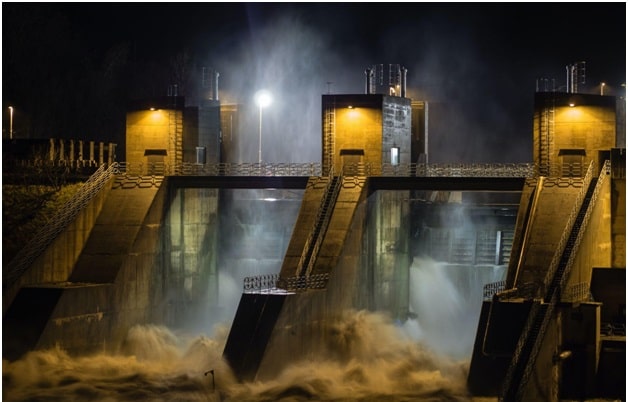There are various sources of clean power generation available today, such as hydroelectricity, wind turbines, solar cells and biofuels. All these options produce power while producing fewer pollutants than fossil fuels do.
Clean electricity means less electromagnetic interference with your electronic devices and fewer spikes and voltage drops which are both detrimental to appliances.
Hydroelectric power
Hydroelectric power is the world’s most-utilized renewable energy source, producing more electricity than any other form and expected to remain as the main source until at least 2030.
Hydropower plants offer an advantage over other clean energy solutions in that they can store energy for future use, making it particularly helpful in meeting fluctuating demands throughout the day and night. Furthermore, hydropower plants typically enjoy long economic lives; maintenance requirements tend to be minimal, making operation a simple affair that doesn’t take much labor.
Hydroelectric plants traditionally utilize dams to store water in reservoirs and then release it when electricity demand peaks, turning potential energy into kinetic energy by passing through spinning turbines that produce electricity for customers to use. This energy can then be distributed among various customers.
Water is typically stored in a reservoir at an elevation higher than where it will eventually be released; the difference in elevation is known as “head”. This creates electricity as the head falls between these elevations.
It eventually flows out through penstocks or large pipes or tunnels leading downhill, creating enough kinetic energy from falling water to turn turbines, turning into electricity before being transmitted across larger distances by means of transformers. You can visit this helpful site for more information.
Some individuals express concerns over the environmental impacts of hydroelectric power, but these issues can be managed through thoughtful engineering and sustainable development.
It’s essential to consider ways of mitigating any adverse impact to wildlife or local communities from hydroelectric plants – for instance large dams may destroy habitats of animals and disrupt migration patterns as well as alter water temperatures and lower oxygen levels that are detrimental to aquatic organisms like fish and aquatic vegetation.
Flooding land for reservoirs can damage towns and villages that rely on rivers for food and shelter, yet its impacts can be minimized through careful planning. Small hydroelectric plants also tend to have less adverse environmental impact as they only divert a fraction of a river’s flow away.
Wind power
Wind energy is one of the cleanest forms of energy available, producing no emissions and helping slow climate change. Furthermore, its renewable nature means it will never run out while being more affordable than fossil fuels; wind’s cost has decreased 47% over 10 years thanks to advances in technology and reduced production costs.
Clean energy industries are expanding quickly; in 2018, they surpassed nuclear and coal for the first time ever in terms of industry growth. Experts predict further surges as clean energy production creates thousands of jobs worldwide while simultaneously supporting global communities. You can visit https://www.c2es.org/content/renewable-energy/ for more information.
Many are intrigued by how clean energy is produced, which includes wind, solar, and biofuel energy generation that doesn’t release harmful pollutants into the environment. Renewable sources play a vital role in this energy mix that will contribute to reducing global warming.
Wind energy can be harnessed in many locations around the world, making wind turbines an efficient means of producing clean electricity. Wind turbines utilize this natural resource by harnessing its force to turn it into clean electricity; their design includes multiple blades connected by an enclosure known as a nacelle that captures its force.
As soon as wind blows over these blades they rotate, turning a shaft within their nacelle which in turn turns on a generator to produce electricity.
Each wind turbine can generate enough power for hundreds of homes. While wind energy is most commonly utilized on land, offshore sites are becoming increasingly popular.
Wind power not only offers energy benefits, but has minimal environmental impacts as well. Wind farms are designed to remain at a safe distance from birds and other wildlife; scientists are researching ways to use sound or light signals to deter birds away from turbines. They’re also discovering more efficient turbine designs.
Solar power
Solar power is one of the fastest-growing renewable energy sources, using electronic devices known as solar cells to convert sunlight directly into electricity.
Solar PV technology can be found everywhere from home solar kits and rooftop installations, as well as large-scale farms. You can visit this site: https://bestestrøm.no/produser-din-egen-strøm-med-solcellepanel/ for more information. In some areas, users may be able to sell excess power back to the company for a profit.
Furthermore, PV farms now feed directly into high voltage transmission networks which transport power across our country – an increasingly attractive energy option indeed!
Solar energy is an eco-friendly source of power that produces no greenhouse gases during production, providing an eco-friendly alternative to fossil fuels that have long contributed to climate change.
The sun produces vast quantities of energy – enough to power our entire planet multiple times over. Some of this comes in the form of direct sunlight which has long been utilized by humanity for crops, heating needs and even cooking food. Nuclear fusion reactions in its core produce huge quantities of hydrogen atoms which are then compressed together by gravity to release immense amounts of energy.
Solar technology has advanced considerably since its early days, becoming more efficient and cost-effective for homeowners and businesses alike.
Now available are passive solar homes which use design to maximize sunlight penetration into a house while batteries store excess energy for use at night; also on the rise are solar-powered cars and buses, many featuring innovations like roof shingles with integrated panels or window screens with solar cells installed directly onto their surface.
Sooner rather than later, renewable energy is projected to make up over half of global energy consumption. Thanks to innovation reducing costs and renewables becoming integrated into electricity systems, more people will enjoy its many advantages.
Biofuels
Biofuel is a renewable alternative to fossil fuels that is composed of plant or animal materials as its feedstock for production. It is commonly blended into gasoline or diesel to increase energy content without increasing prices; carbon neutral biofuel does not contribute any additional greenhouse gases when burned.
Most biofuels are created through the fermentation of organic material, breaking down starches and sugars in plant material to produce ethanol. Researchers are developing techniques for using non-edible parts of plants like cellulose and hemicellulose in order to make more carbon-conscious biofuels such as biodiesel and jet fuel.
These technologies utilize less land than traditional biofuel production and can easily fit into existing agriculture practices. Furthermore, they reduce pesticide and fertilizer usage that pollute the air and water supply, providing more cost-effective alternatives than fossil fuels.
Clean energy development is of great significance for humanity’s future. It will protect the planet from climate change and other environmental hazards while also creating jobs in renewable energy industries. One effective way to promote its use is by encouraging governments and companies to invest in it.
Many biofuels have already reached commercial maturity, such as ethanol for transportation and biodiesel for heating and cooling applications. To reach net zero emissions by 2030, however, more advanced biofuels must be created which are even more effective at curbing carbon dioxide emissions.
At present, most biofuels used for transport include bioethanol and biodiesel, blended into conventional gasoline or diesel. These fuels can be found in cars, trucks and airplanes alike and significantly decrease emissions such as carbon monoxide.
There are many different types of clean energy. These methods of producing energy can be combined to help ease the planet’s population’s dependency on fossil fuels. This, in turn, will have a positive impact on greenhouse gas emissions.
Consumers can help the environment by being knowledgeable about different types of power and seeking out green solutions whenever possible. They can also help by trying to conserve whenever possible.


